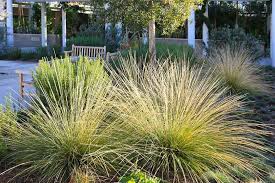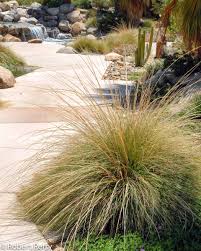Deer Grass, scientifically known as Muhlenbergia rigens, is a kind of grass that you can often find in the southwestern part of the United States. Even though its scientific name might sound a bit tricky, Deer Grass itself is actually quite simple to recognize and enjoy. It has tall and skinny stems that look really nice, and it’s a plant that many people like to have in their gardens.
The cool thing about Deer Grass is that it’s really good at living in places where there’s not a lot of water. This makes it a favorite choice for gardens in areas where it doesn’t rain much. It has these long and feathery parts on top that sway back and forth when the wind blows, which looks super nice and makes the garden seem fancy.
Another interesting fact about Deer Grass is that it can be helpful in stopping the soil from getting washed away. So, if you have a place where the dirt might go away because of water, you can plant Deer Grass there, and it will help keep the soil in place. Also, small animals like to live around Deer Grass because it gives them a cozy home.
If you don’t want to spend too much time taking care of plants, Deer Grass is perfect for you. Once you put it in the ground and let it settle, it doesn’t need much water to be happy. It’s like a low-maintenance friend that doesn’t ask for a lot. You can find Deer Grass hanging out in groups in nature, which looks really pretty, especially when the sun sets and makes it all golden and nice.
People who love plants and making gardens look cool often use Deer Grass to make things interesting. They put Deer Grass next to other plants that don’t need a lot of water, and it’s like a team of plants that can survive even when it’s not raining much. This is good because it saves water, and it also looks awesome.
However, Deer Grass (remember, that’s Muhlenbergia rigens) is a simple and pretty grass that likes to live in places where there’s not a lot of water. It might have a fancy scientific name, but it’s easy to enjoy its beauty. With its tall stems, relaxing swaying, and ability to be tough in dry places, Deer Grass is a fantastic choice if you want your garden to look nice without too much work.
Read Also: 11 Healing Powers of Siam Weed (Awolowo Leaves) Updated
Growing and Care Guide of Deer Grass

Here’s a simple growing and care guide for Deer Grass:
1. Planting:
Choose the Right Spot: Pick a sunny area in your garden where Deer Grass will get plenty of sunlight. It can also tolerate light shade.
Soil Preparation: Make sure the soil is well-draining. You can improve drainage by adding sand or gravel to the soil.
Planting Depth: Dig a hole slightly larger than the root ball of the plant. Place the Deer Grass in the hole, making sure it’s at the same level it was in the container.
Spacing: Space multiple plants about 2-3 feet apart to give them enough room to grow.
2. Watering:
Establishment Period: Water newly planted Deer Grass regularly for the first few months until it becomes established. This helps the roots take hold.
Established Plants: Once established, Deer Grass is drought-tolerant. Water deeply but infrequently, allowing the soil to dry out between waterings.
3. Maintenance:
Pruning: Deer Grass benefits from a yearly trimming in late winter or early spring. Cut back the old growth to about 6 inches above the ground.
Fertilizing: Deer Grass doesn’t require much fertilizer. You can apply a balanced, slow-release fertilizer in the spring if desired.
Mulching: Apply a layer of mulch around the base of the plant to help retain moisture and control weeds.
Division: Over time, Deer Grass can become overcrowded. You can divide the plant every 3-4 years in early spring to rejuvenate it.
4. Troubleshooting:
Pests and Diseases: Deer Grass is generally resistant to pests and diseases. However, keep an eye out for aphids or mealybugs.
Yellowing Leaves: If the leaves turn yellow, it might be a sign of overwatering or poor drainage. Make sure the soil isn’t too soggy.
5. Benefits:
Water Efficiency: Deer Grass is a water-wise choice for landscapes that don’t get much rain.
Wildlife Habitat: The grass provides a cozy home for small animals and insects.
Erosion Control: Its root system helps prevent soil erosion in vulnerable areas.
Low Maintenance: Once established, Deer Grass requires minimal care.
Remember, Deer Grass is pretty adaptable and forgiving, so don’t worry too much about getting everything perfect. With a bit of attention in the beginning and some occasional care, you can enjoy the beauty and benefits of Deer Grass in your garden.
Read Also: Harvesting and Processing Of Cacao Fruits
Importance of Deer Grass

Here are 9 wonderful reasons why Deer Grass (Muhlenbergia rigens) holds importance:
1. Water Conservation: Deer Grass is a water-efficient plant, making it a valuable choice for regions with water scarcity. Its ability to thrive with minimal water helps conserve this precious resource.
2. Drought Resistance: In landscapes prone to drought, Deer Grass offers a resilient solution. Its natural ability to withstand dry conditions makes it an ideal plant for maintaining greenery even during water shortages.
3. Erosion Control: The strong and deep root system of Deer Grass helps stabilize soil on slopes and vulnerable areas. By preventing erosion, it plays a crucial role in maintaining the integrity of landscapes and preventing sediment runoff.
4. Wildlife Habitat: The dense growth of Deer Grass provides a haven for various small animals, insects, and birds. These creatures find shelter and nesting opportunities within its swaying stems, contributing to local biodiversity.
5. Carbon Sequestration: Like many plants, Deer Grass contributes to carbon sequestration by absorbing carbon dioxide from the atmosphere during photosynthesis. This aids in mitigating the effects of climate change.
6. Visual Appeal: The graceful and feathery appearance of Deer Grass adds texture, movement, and beauty to landscapes. Its swaying seed heads catch the sunlight and create a soothing, natural ambiance.
7. Low-Maintenance Landscaping: For those seeking a garden that demands less care, Deer Grass is an excellent choice. Once established, it requires minimal attention, reducing the need for frequent watering and maintenance.
8. Native Plant Support: Using native plants like Deer Grass in landscaping projects promotes the preservation of local ecosystems. Native plants are adapted to the region’s conditions and support native wildlife.
9. Educational Value: Deer Grass serves as an educational tool, showcasing the importance of using native and drought-tolerant plants in landscaping. It encourages awareness about sustainable gardening practices and the need to conserve water.
In summary, Deer Grass holds multiple wonderful importance ranging from water conservation and erosion control to supporting wildlife and offering visual charm. Its ability to thrive in dry conditions, while adding ecological and aesthetic value, makes it a cherished asset in various landscapes.
Read Also: How to Upscale Your Sales With Google My Business
